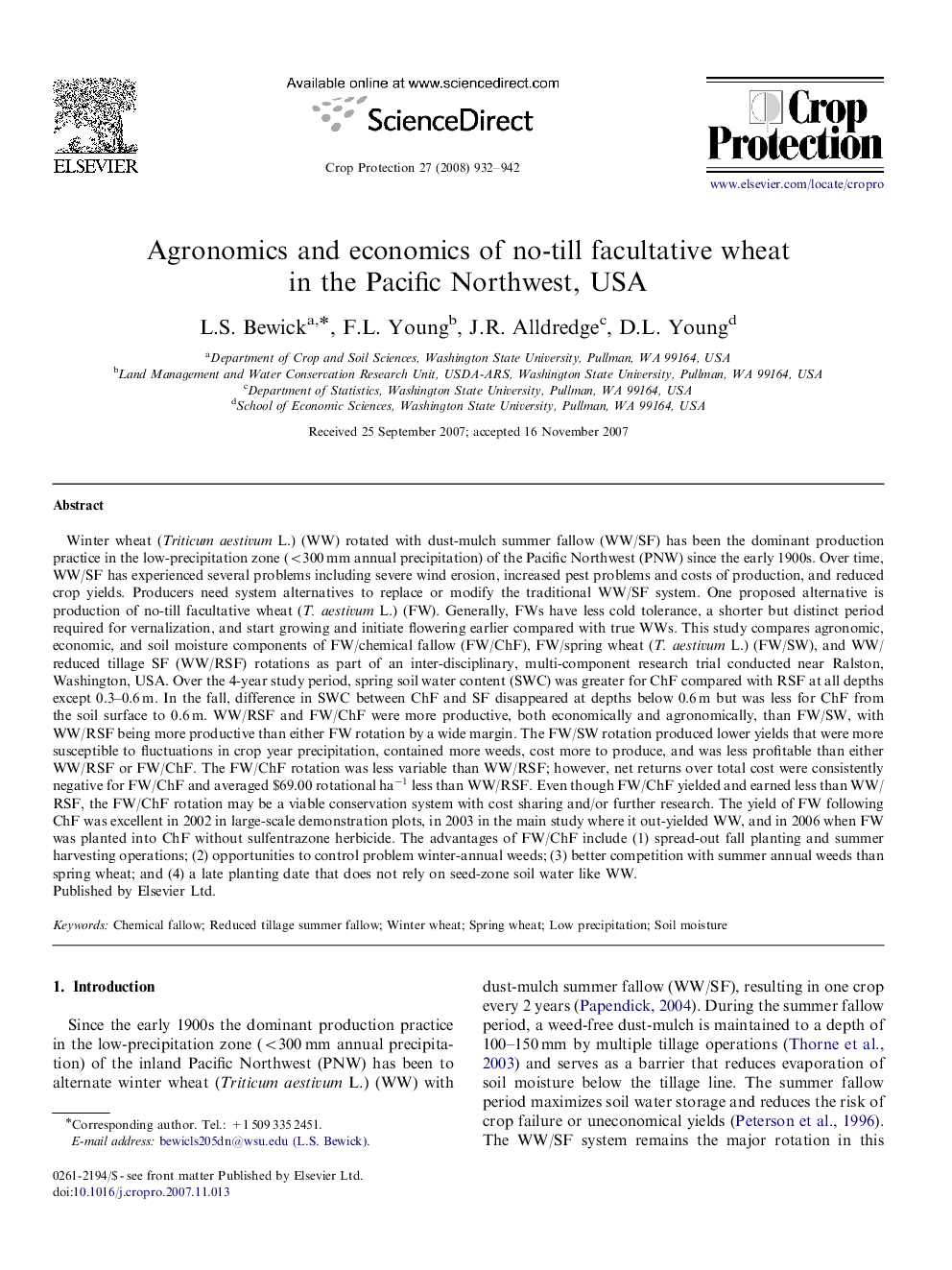| کد مقاله | کد نشریه | سال انتشار | مقاله انگلیسی | نسخه تمام متن |
|---|---|---|---|---|
| 4507637 | 1321372 | 2008 | 11 صفحه PDF | دانلود رایگان |
عنوان انگلیسی مقاله ISI
Agronomics and economics of no-till facultative wheat in the Pacific Northwest, USA
دانلود مقاله + سفارش ترجمه
دانلود مقاله ISI انگلیسی
رایگان برای ایرانیان
کلمات کلیدی
موضوعات مرتبط
علوم زیستی و بیوفناوری
علوم کشاورزی و بیولوژیک
علوم زراعت و اصلاح نباتات
پیش نمایش صفحه اول مقاله

چکیده انگلیسی
Winter wheat (Triticum aestivum L.) (WW) rotated with dust-mulch summer fallow (WW/SF) has been the dominant production practice in the low-precipitation zone (<300 mm annual precipitation) of the Pacific Northwest (PNW) since the early 1900s. Over time, WW/SF has experienced several problems including severe wind erosion, increased pest problems and costs of production, and reduced crop yields. Producers need system alternatives to replace or modify the traditional WW/SF system. One proposed alternative is production of no-till facultative wheat (T. aestivum L.) (FW). Generally, FWs have less cold tolerance, a shorter but distinct period required for vernalization, and start growing and initiate flowering earlier compared with true WWs. This study compares agronomic, economic, and soil moisture components of FW/chemical fallow (FW/ChF), FW/spring wheat (T. aestivum L.) (FW/SW), and WW/reduced tillage SF (WW/RSF) rotations as part of an inter-disciplinary, multi-component research trial conducted near Ralston, Washington, USA. Over the 4-year study period, spring soil water content (SWC) was greater for ChF compared with RSF at all depths except 0.3-0.6 m. In the fall, difference in SWC between ChF and SF disappeared at depths below 0.6 m but was less for ChF from the soil surface to 0.6 m. WW/RSF and FW/ChF were more productive, both economically and agronomically, than FW/SW, with WW/RSF being more productive than either FW rotation by a wide margin. The FW/SW rotation produced lower yields that were more susceptible to fluctuations in crop year precipitation, contained more weeds, cost more to produce, and was less profitable than either WW/RSF or FW/ChF. The FW/ChF rotation was less variable than WW/RSF; however, net returns over total cost were consistently negative for FW/ChF and averaged $69.00 rotational haâ1 less than WW/RSF. Even though FW/ChF yielded and earned less than WW/RSF, the FW/ChF rotation may be a viable conservation system with cost sharing and/or further research. The yield of FW following ChF was excellent in 2002 in large-scale demonstration plots, in 2003 in the main study where it out-yielded WW, and in 2006 when FW was planted into ChF without sulfentrazone herbicide. The advantages of FW/ChF include (1) spread-out fall planting and summer harvesting operations; (2) opportunities to control problem winter-annual weeds; (3) better competition with summer annual weeds than spring wheat; and (4) a late planting date that does not rely on seed-zone soil water like WW.
ناشر
Database: Elsevier - ScienceDirect (ساینس دایرکت)
Journal: Crop Protection - Volume 27, Issue 6, June 2008, Pages 932-942
Journal: Crop Protection - Volume 27, Issue 6, June 2008, Pages 932-942
نویسندگان
L.S. Bewick, F.L. Young, J.R. Alldredge, D.L. Young,